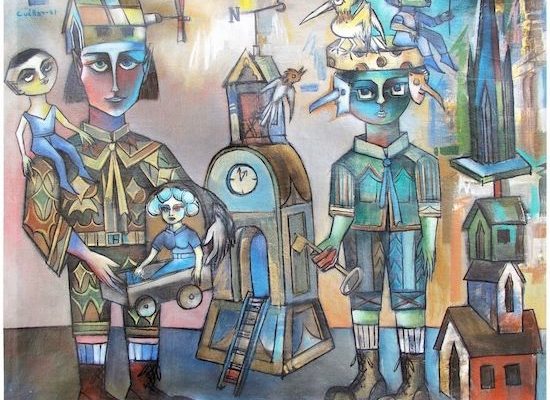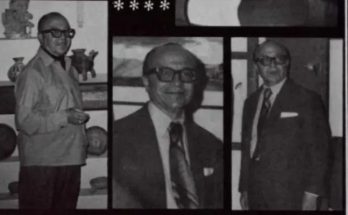By Luis Felipe Rodriguez
Jesús Nicolás Cuéllar Hernández, one of San Miguel de Allende’s few native artists, was born at Calle Jesus 42 in 1927 and spent most of his life in the same house. As a child, encouraged by his Catholic mother and the nuns at his school, he began painting images of saints. They had recognized his talent and pushed him to paint with oils. He also made sculptures from quarry stone.
His father, Nicolás Cuéllar Vázquez, first worked in a fabric factory and later made a living selling fruit from the family’s orchards. His mother, Eleuteria Hernández Pérez, was a housewife. His three siblings were much older. Because of the difference in age, he grew up relatively alone and developed a strong imagination and creativity. He remembered his childhood days as magical, but not without hardship. “I grew up with my mother and siblings: two brothers (Antonio and Federico) and a sister (“Luz, my beloved sister who loved me so much.”). He had a loving relationship with his father and remembers the phrase his father always used when he arrived home: “Meet me, and give me your thoughts,” giving him a candy or a coin. His father died when Cuéllar was only 10, and the boy felt his departure keenly. He immortalized his death in a 1996 painting showing a child before a coffin, titled “My Father.”
Many of his paintings harken back to his childhood. Examples include “Nicholas’s Games” and “Children Playing by the Church.” Both were painted in 1977 and show clear autobiographical elements. His older brothers called him “the engineer” because of his skill in building artifacts and repairing machines. He captured this years later in paintings such as “Urban Metamorphosis” (1990) and “Machinery” (1978).
At 21 he fell in love with and married María Socorro González, an intelligent young woman of great beauty, originally from Dolores Hidalgo. Nicknamed Coco, she was his one and only muse. They had six children, of whom he always very proud. As a newlywed, he and his wife moved to Mexico City, where he began studying painting at the San Carlos Academy in 1954.
Cuéllar admired Diego Rivera and wanted to immerse himself in the Mexican School of Painting. Instituto Allende was best suited to this goal, so he returned to San Miguel in 1955 and continued his studies at the Instituto until 1957. James Pinto and Jack Baldwin taught him, and he retained fond memories of them. Pinto, who had studied with Siqueiros, taught him muralism.
At the Instituto, he was recognized as a brilliant student “with a very fine and creative line,” according to Pinto. Another teacher and advisor, when he visited the Instituto, was Rufino Tamayo. Lithographs from this period include “Children with Stars,” “El Penitente,” and “Charamusquera.”
In 1962, Cuéllar received a scholarship to study at the Brooklyn Museum Art School in New York. While there, he was exposed to the great Renaissance masters, as well as modern and contemporary painting. The works of Rembrandt, De Chirico, Bosch, Brugel, Cézanne, Gauguin, Lautrec, Modigliani, Laktionov, Picasso, and other masters made a deep impression and influenced his work.
Cuéllar concluded his studies in 1963 and returned to Mexico the following year. Back in his homeland, he sought inspiration, having felt depressed by the weather in New York, the violence of President Kennedy’s assassination, and the Cold War between the United States and the then-Soviet Union. Although the Bay of Pigs events of 1961 had passed, the danger of another world war always seemed to be looming. He showed his feelings about these situations in a pictorial series he called “War and Peace,” with paintings like “The Empire of a Thousand Faces” (1972), “Building Destinies” (1982), and “Empire of Evil” (1978). His love of peace can be seen in his fascinating work “Culture and Peace” (1997).
Those who knew him personally remember him as elegant and distinguished. He preferred light-colored clothes and always wore a hat, something that began in the 1940s. When he took off his hat, his abundant head of hair tumbled out. Cuéllar spent time every day on a bench in the Jardin in front of the Parroquia. The structure is an icon not only of the city, but also in his own work. He depicted the Parroquia in drawings and paintings in various styles.
Cuéllar spent most of his career in Sand Miguel and was well respected by the artistic community here and as a teacher. He received hundreds of friends, artists, and tourists in his home; people from abroad were drawn to his art. In his house was a gallery and a studio, where he exhibited some of his work. By Cuéllar’s own interpretation, his works were a blend of magical surrealism influenced by Mexican folklore from his early days, when his mother’s old Singer sewing machine, covered with a hand-painted blanket, served as a desk in the entryway.
Cuéllar died in 2010 at the age of 83 in the city where he was born, surrounded by his loving wife Coco and their children. His remains lie in the family crypt in the Basilica of Guadalupe in Mexico City.




